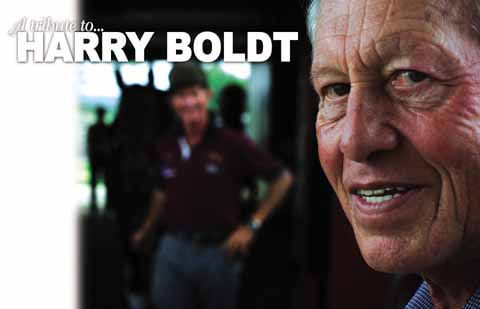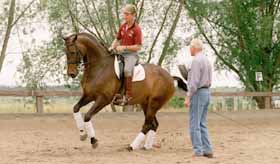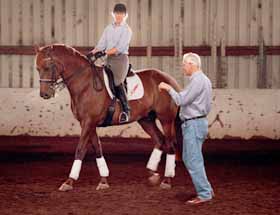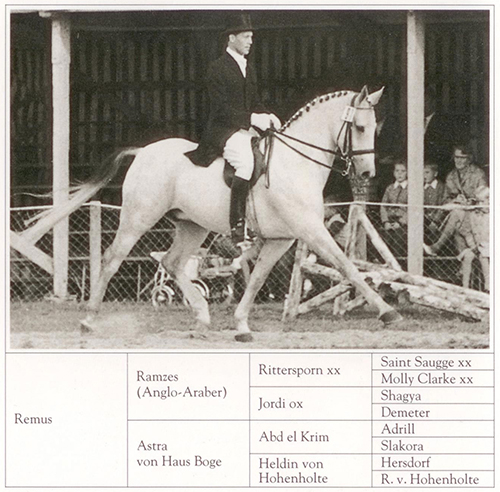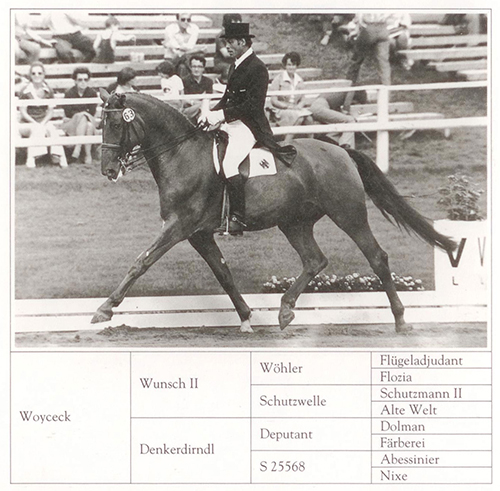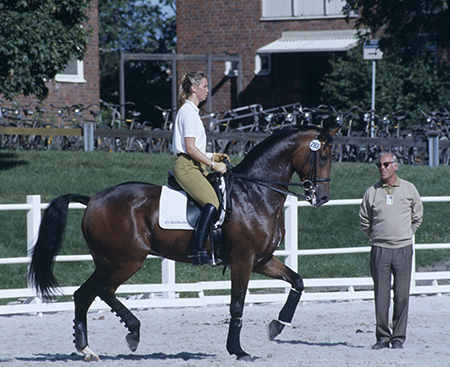The business card of one of the greatest equestrians in the world really says it all. In plain print, it reads, quite simply, Harry Boldt. ANN-MAREE LOUREY meets the man behind the card…
Photos by Peter Stoop
In the arena of the NSW Equestrian Centre in the Hunter Valley, NSW, Heath Ryan is uncharacteristically quiet as he runs his horses by one of the world’s great master trainers, Harry Boldt. Stilton is being put through his paces while Harry sits quietly in a chair in the corner, occasionally rising to walk beside the piaffing horse, a hint of piaffe in his own footwork. He doesn’t say a lot, but it means a lot.
Heath is encouraging “Stilts” to greater heights in the piaffe. “Yes! Yes! And forward! Keep going!” says Harry by his side. “Not too quick! Not too quick!” Harry chuckles as Stilton hesitates and threatens to alternately look backwards or sit wide behind. He is breathing hard, working at top concentration, and Harry is smiling his wide smile with glee as the horse gets it all right.
Heath works Stilton in a version of rein-back piaffe, perfect in rhythm and encouraging him to take greater weight on the hind legs. A short break, and on to canter. Harry’s “eyes on the ground” watch the pair from the centre of the arena. Three movements later – approval.
“Good!” They move onto canter pirouettes. “Go, go, go!” encourages Harry. “Make him a little bit quicker, let him down, don’t pull him tight.”
The pirouettes improve before our eyes, become more fluent, move onto the centreline to practise as per the test, pop up all around the arena until “that’s enough pirouettes!”. Heath was having fun. Two sets of tempis, then back to the piaffe. Piaffe-walk, into the piaffe rein back again and it’s really working . You get the feeling, watching, that it should be one of those segments on TV that says “Please do not attempt this trick at home”, so fraught with danger is it. You can see that Heath has fastened onto the idea with great glee. Just so long as he doesn’t expect his students to be able to do it too…
The horses continue, Rozzie Ryan on Exellent, Heath on Greenoaks Dundee, Rozzie on Arglen Kaleb, Heath on Greenoaks Legend, Harry occasionally handing out a specific mark for a movement and explaining succinctly why it would score such a mark. He doesn’t tell them how to ride so much as point out any incorrectness, a way to improve, a way that he would change a movement.
The always very switched-on Kaleb is working hard at improving his suppleness and rideability in the one-times, when he almost stops dead in the face of our camera flash – a bit of a spook, it does him good to find a competition distraction on home ground and four shots later he isn’t even looking. Harry is more interested in slowing down the canter, keeping him up but not tight, keeping the forehand leading in the canter half pass.
Later, I curl up in front of the Ryans’ fire, notebook in hand, to find out who exactly is Harry Boldt?
I can be forgiven for lacking in history, after all, Harry was coaching gold medal winners before I knew what dressage was! In fact, I was still sitting in class when he quit riding for teaching…
He kicks off with a discussion on his day’s lessons.
“GV Stirling Stilton is not an easy horse, he is not born a dressage horse, but with dressage training and gymnastic …. the hind legs come elastic and soft and it is possible to bring the horse to Grand Prix,” Harry explains. “The first idea was for him to be an eventer, then later he learnt everything and he is a Grand Prix horse now. You see that it is difficult to develop the piaffe – you can try different things – the result must be the same but every horse is different. You cannot work every horse to the same method. To try from rein back to piaffe, then piaffe forward, his hind legs are more under and then you have softer piaffe. When you have a horse that has very active hind legs you don’t need that but not every horse is perfect in its exterior.”
“Many people start the piaffe with quick steps – don’t let them do this, come from passage steps, keep them short and keep going and one day the horse will have a beautiful piaffe.”
How, I wondered, did Harry reach a point where his lifestyle involves travelling around the world commenting on the achievement of piaffe?
Happy to expand, he took me right back to his childhood and began from scratch. Now 71 (though you would never guess!), Harry can spin a good yarn on any topic from any era at the drop of a hat.
“My background? My father had a riding school – all my life I saw horses,” he reflected. “I grew up with horses… it was the normal riding school you have in the big cities in Germany. There are always people who want more, they want to go to the highest levels and compete. We have from normal riders for pleasure to other riders who want to be top riders in the competition.”
The “riding school” at Essen would have been a major equestrian centre by Australian standards and was one of the biggest even in Germany. “Verein for Reitsport” had two indoors and 100 horses, all under the watchful eye of his father Heinrich Boldt, until its operations were interrupted by World War II.
“For six years there was really a break for everyone,” Harry remembers – and especially for his own riding, which was virtually put on hold from age nine to 15.
“Later on from ’48 the times became normal, you could buy horses again by ’48/’49. The farmers started breeding horses again, things were developing again. The riding school started again. Then I worked every day after school, watching, helping. It was normal that one day my father says: ‘Come, I have a quiet horse, hop on.’ I learnt quick, it was not a problem, I was a teenager.”
Harry started off his competitive career in national showjumping classes, but dressage was to take over.
“I think in ’49/’50 I had my first successful start in competition, I won it, it was the lowest level but I won it.”
“Then the horses were better and better, and from ’55 I think I started Prix St Georges.”
“1956 I started in selection trials for Melbourne and Stockholm. I competed already to try to be a member of the team.”
“Then I had a really good few years, ’58/’59/’60, with really good horses, already at Grand Prix level. I won the Grand Prix at Aachen at this time. I was nearly 25 years at this level (international Grand Prix) until 1980.”
Trained by Kathe Franke, Harry competed in international Dressage Derbies during the 1960s.
“There was the Olympics in Tokyo in 1964, the Olympics in Montreal in 1976, and in between many times in the team for the European and World Championships – from ’66 there was World Championships in dressage. In 1964 I was silver individual and gold team medal (on the Westphalien Remus), the same in Montreal (this time with Woyczek).”
Harry Boldt and Remus
“At this time (in the early 60s) there was Granat and Christine Stuckelberger, the Swiss were very strong in 1964 and there was the Swiss cavalry in Berne – they had some good riders and some good horses, they rode Spanish horses – but this is all gone now. The Swiss are so down at the moment.”
“In 1980 I finished competing. I was on Charles, I did the last show of the outdoor season in Europe and I won it and told the Press that it was my last start. They couldn’t believe it.”
In fact, up to 1979 Harry claimed three German championship titles and had won seven individual and eight team medals at European and World Championships.
Harry and his pupil, Nicole Uphoff and Rembrandt at the first WEG, Stockholm, 1990
“Then I was thinking about starting as a trainer, from 1981. The German Equestrian Federation asked me if I was interested in being the coach – OK, I had support from the riders, they wanted it that I took over but it was a shock. The coach then was Willi Schultheis until 1980, and then they asked me and I was coach from 81 to 96. I never thought that I would be so long a coach of the German team. The Atlanta Olympics was my last job.”
“And I always stabled 10 horses, still worked with the horses, dealing with horses, buying and selling, but there wasn’t so much time from 81 on. In 1992, after Barcelona, I was a part-time coach, half a year in Germany and half a year in Australia. Every year in Europe is something, a World or European Championship or an Olympics, so half a year before that I was training the short-listed riders for the selection trials, up to the championships, then I came back here to Australia. I did that from 93 to 96, then from 97 I am more here than in Germany but still travelling. In the last half year, for eight or nine months before the Olympics I helped the Australian riders together with Clemens Dierks. I helped him a little bit – he was the coach. And that intensive training – the team was 6th in Sydney!”
Harry is proud of that achievement – no mean feat for Australia but not quite in the same league as his achievements in Europe. Under his supervision, the German team collected 50 medals at Olympic, European and World championships, 31 of them gold.



